A day trip to Miyajima Island is a must-do while in Hiroshima. It’s one of Japans top 3 scenic spots, easy to get to and there’s so much to see and do here
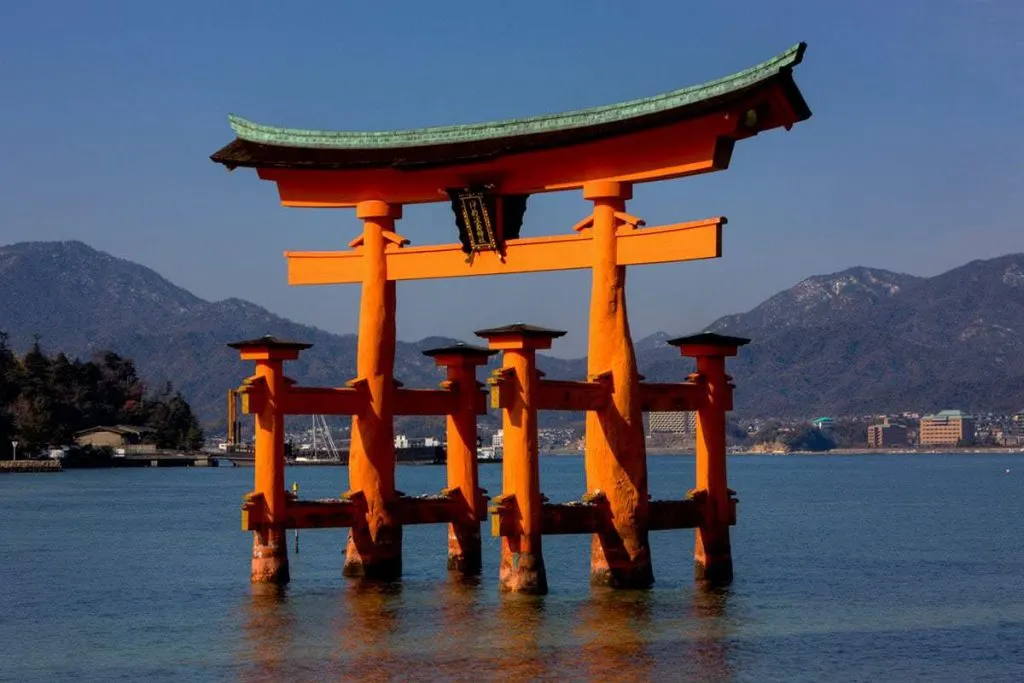
If you’re staying in Hiroshima then we’d recommend spending a full day on Miyajima Island. If your time is more limited it’s also possible to do it as a long day trip from cities like Kyoto, Osaka or Kobe especially if you’re using the JR Pass.
The bullet train, local train and ferry are all run by Japan Rail and are included in the pass making it cost-effective and easy to coordinate. There’s more information on doing longer distance days like this in our post the 10 best day trips from Kyoto.
Table of Contents
Our top 11 things to do on Miyajima Island
A few people will visit Miyajima Island, snap a few images of the famous floating torii and head off. Others will stay overnight or for a few days on the island. We’ve visited a couple of times on a day trip from Hiroshima city. The ferry starts early in the morning and runs into the evening so day trips have worked well for us but next time we plan to stay on the island just to have that experience, it’s a lot more tranquil early or later in the day.
The priority for most people is to be there for high tide when both the Torii and the shrine itself appear to float on the tide. It’s really worth being there to see it right at the top of the tide as the bay is very flat and the tide departs quickly. You can use this link to check the high and low tide times in English for the date of your visit.
The Floating Torii
The great Torii gate in the distance with the shrine behind is one of your first images of Miyajima Island as you approach on the ferry but you’ll see it much closer and more clearly once on the island. During the high tide it appears to be floating in the sea and at low tide, you can walk out to it and pass through the gate.
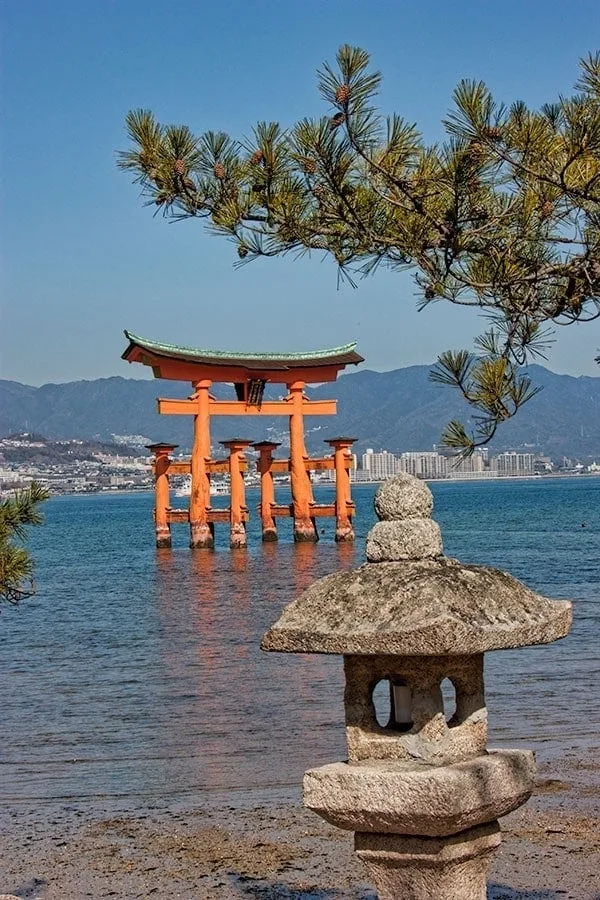
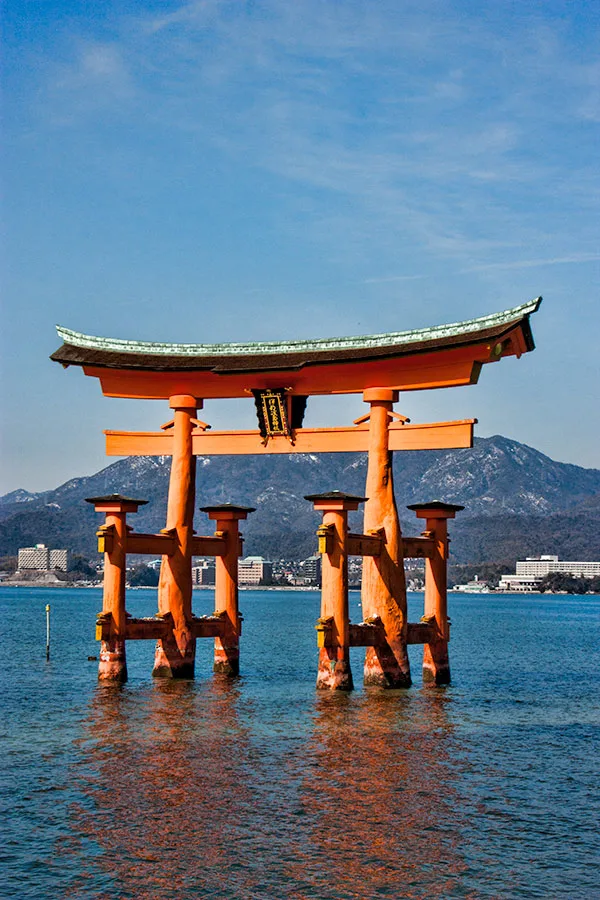
The first great Torii on the site was built in 1168 and the gate you see there today is the 8th iteration built in 1875. A torii is a gate between the everyday world and the sacred space, in this case, Itsukushima Shrine. The vermilion colour, that unique orange you see on shrine buildings and at some temples across Japan is believed to keep evil spirits away so in a way by entering through the gate you are both being respectful and purifying yourself of evil spirits before entering. If you’re interested take a read of this post discussing the right way to enter and other shrine etiquette for visitors.
I imagined that the gate must be driven deep into the seabed to make it stable but although it stands on a base of stones strengthened at sea level with stakes it actually stands under its own weight, all 60 tonnes of it. It’s built from naturally grown cedar trees with cyprus thatching on the roof which also encloses about 7 tonnes of stones to assist in keeping it balanced. It all sounds a bit precarious if you didn’t know that it had stood in its various forms for so many centuries.
The Deer
There are loads of whitetail deer around the island, you’ll see them outside the ferry terminal when you first arrive and we’ve seen them way up the top of Mt Misen. Whether you love them or avoid them they do mostly congregate where there the people are. Those big eyes are great for manipulating treats out of unsuspecting visitors. Perhaps because we don’t feed them we’ve not had an issue with the deer anywhere in Japan but we have seen them pestering some people and they can be a bit mischievous having a nibble on the odd handbag or attempting to share a snack.
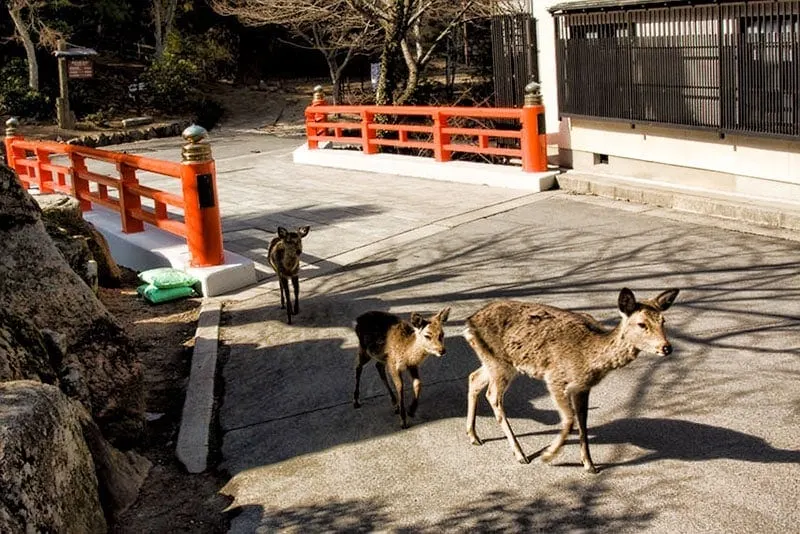
This mum with two fawns followed us up to Daisho-in temple, they are extremely cute and I personally love to see them here. The island has plenty of natural shrubbery for them to eat a little way out of town so they don’t need to eat human food and in the long run, it can’t be good for them.
Omotesando Shopping Street
The shopping street between the ferry terminal and the shrine is a popular spot for buying souvenirs (omiyage), having a meal or picking up a snack. There’s even a little spa where you can have a fish nibbling pedicure if you’ve been meaning to try this unique treatment.
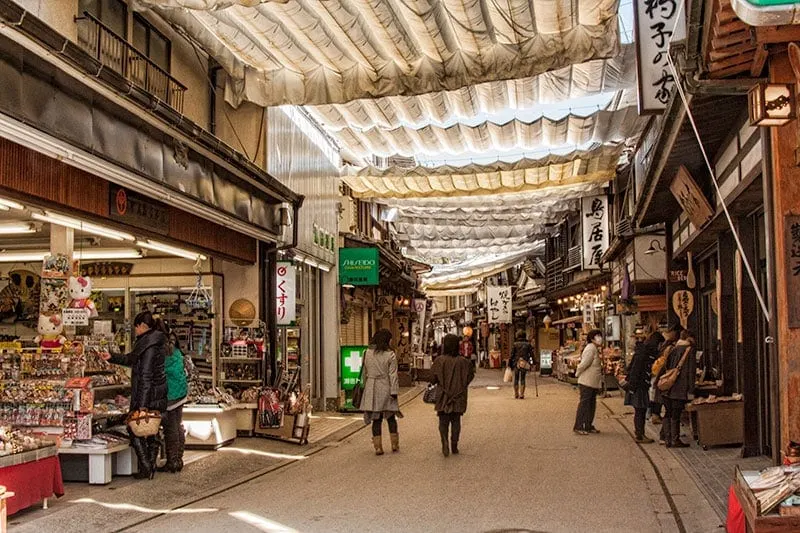
Itsukushima Shrine
The island takes its name because of this shrine. Originally named Itsukushima the same as the shrine and subsequently Miyajima which literally means Shrine Island. The floating torii was the entrance gate for this shrine, once accessed by boat directly to the shrines own pier. The shrines spirituality is intense, even crowded with people so it’s not surprising that the island has been recognised as a spiritual place for so long. The shrine was believed to have been first founded in 593 although the first documented record isn’t until 811 and the basis of the current design dates back to 1168.

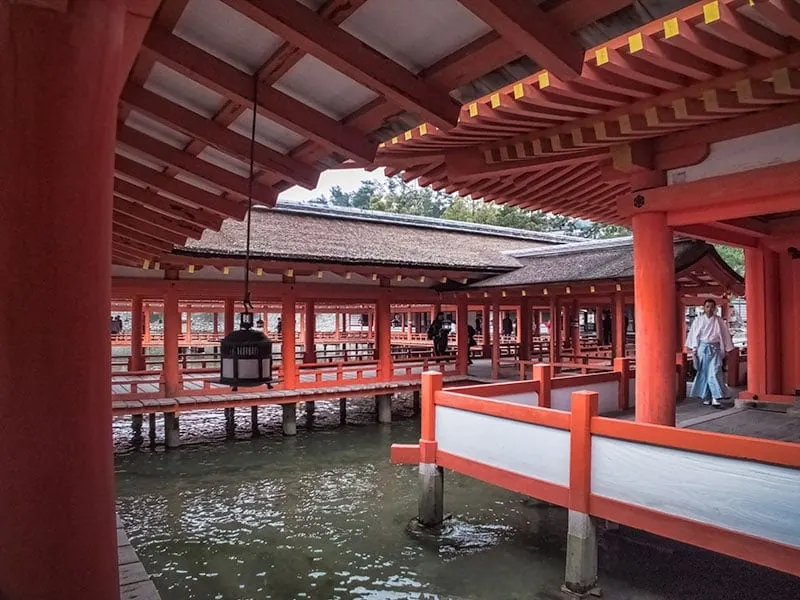
The complex consists of several halls and shrines interconnected by corridors lit with lanterns, the entire shrine standing on pillars above the tide. If you have the opportunity it looks stunning lit in the evening although you can’t enter it after dark. The stone lanterns on the far side and the torii are also lit up at night until 11pm.
5 Story Pagoda
The tall vermilion pagoda on the hill high above Itsukushima Shrine is part of Toyokuni Shrine and is called Goju-no-to. It was built in 1407 and restored in 1533, it’s current glossy lacquer applied as part of a subsequent restoration in its original style in 1945 to further protect it from the elements. The pagoda enshrines the Medicine Buddha along with Buddhist saints Fugen and Monju who are more commonly depicted as a triad with Shaka (Shakamuni) the historical Buddha.
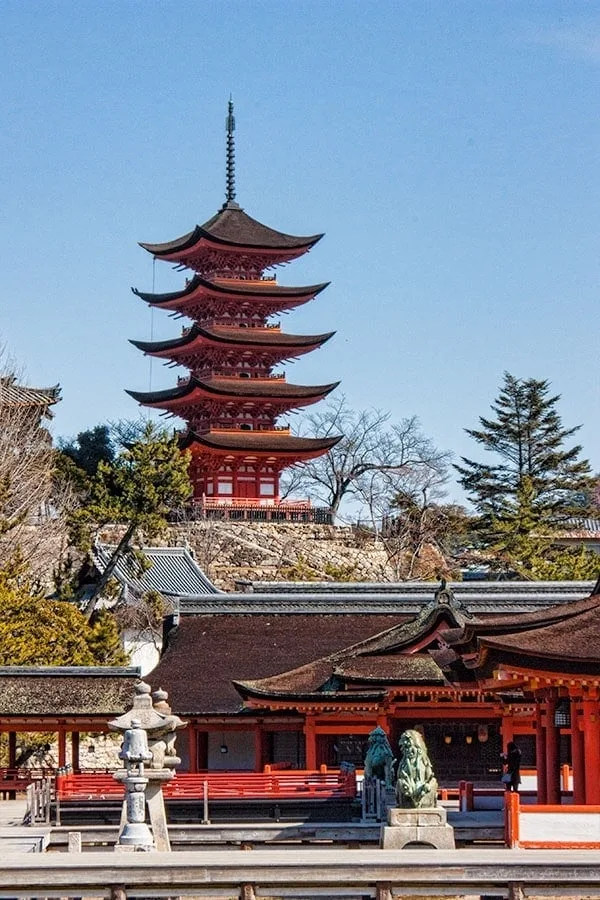
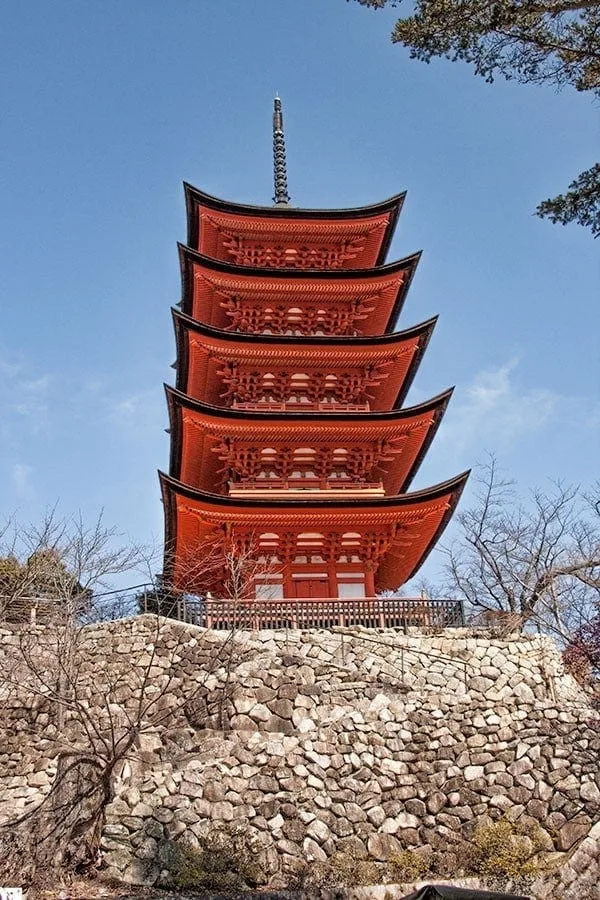
You aren’t able to enter the pagoda but the Hall of 1000 tatami mats is open. It has a interesting history that intertwines Buddhism and Shintoism. It was commissioned in 1587 to a a Buddhist library for the chanting of sutras and dedicated to Toyotomi Hideyoshi one of Japans 3 great unifiers. Construction was halted when Hideyoshi died 11 years later and it stands partly completed today a mix of grandeur and abandonment. Originally Amida was enshrined in the Buddhist alter but since the Meiji period, it has been used exclusively in Shinto rituals. It’s the largest structure on the Island.
Daisho-in Temple
I really enjoy this temple which wears its very long history with an element of modern kawaii culture. Daisho-in is said to have been founded by the monk Kukai (posthumously Kobo Daishi) back in 806 when he visited the island. Its many halls and treasures reflect its long history and importance to both the people and historic imperial rulers of Japan.
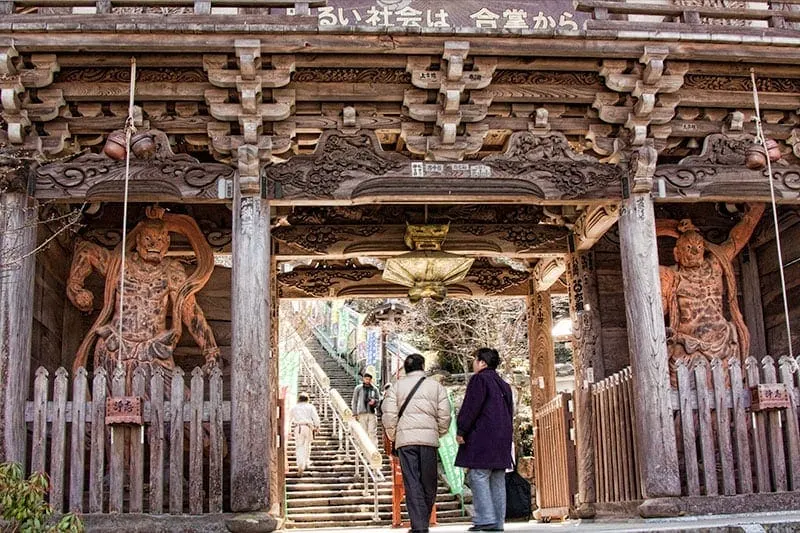
If you’re planning to stop in here you can read more on our post on Daisho-in temple.
Mt Misen
Whether you use the ropeway (mentioned below) or climb it yourself Mt Misen is definitely worth making time for. Primordial forest, giant boulders, ancient temples, incredible views and its own legends there’s something here to interest everyone.
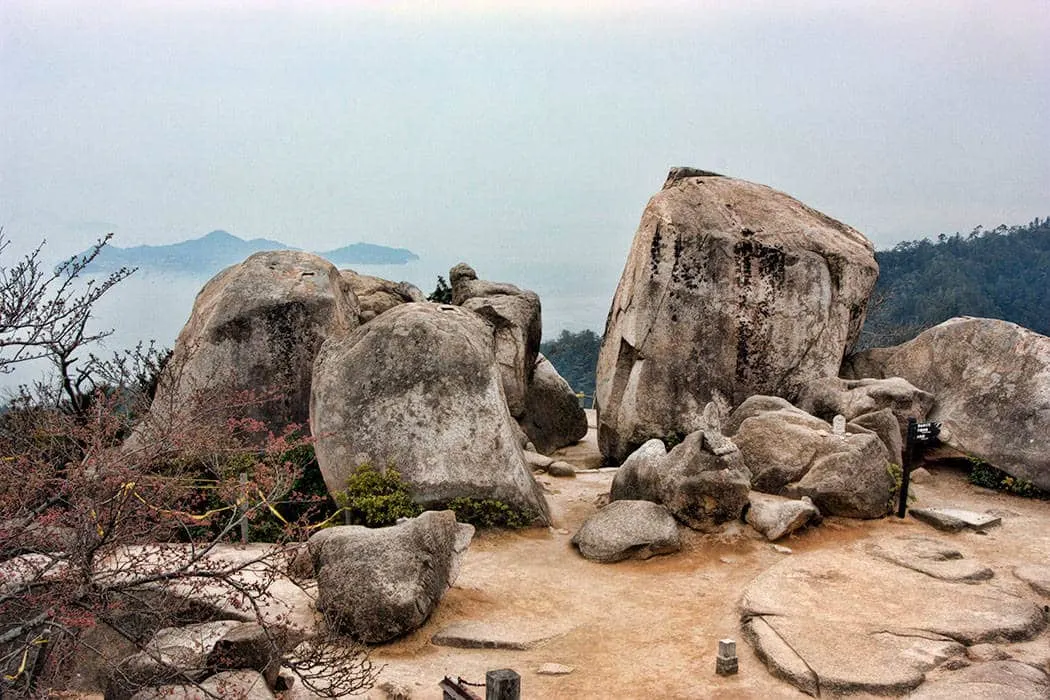
If you’re going to explore the mountain get the extra information you need from our post on the stunning Mt Misen.
Joining a tour with a local guide
To see as much of Miyajima Island as possible in a single day and understand the culture and important history of the area you might choose to see the area with a local guide.
Magical trip runs a small group, full-day hiking tour that takes you off the beaten path and beyond the famous shrine. You’ll hike up Mt Misen, enjoy the views and lunch at the summit then take the ropeway back down to Momiji Dani park.
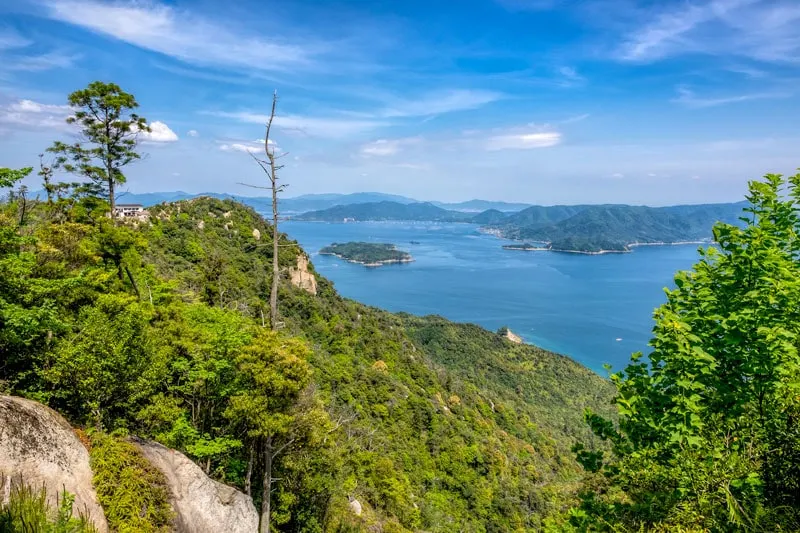
Ropeway
If you have the time then taking the ropeway up Mt Misen is well worth the trip. There’s a bit of luck involved in picking the right day to go, the views are stunning on a clear sunny day, especially in winter when you don’t get the heat haze.
It took us a couple of trys to hit the perfect weather but even when it was a bit overcast were still able to enjoy the view both from the ropeway itself and from the top. If you’re able to make the walk I recommend continuing on to the top, make sure you take a drink and have shoes suitable for walking a smooth dirt track.
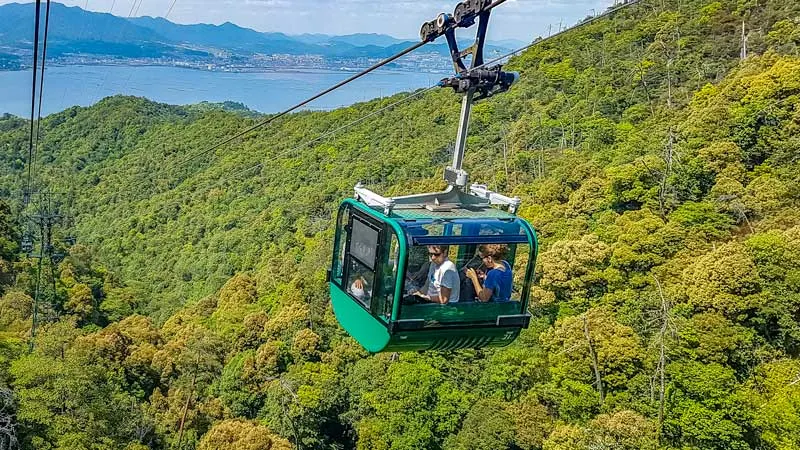
The hours vary slightly by season but it runs at least 9am to 5pm. An adult fare is Y1800 return or Y1000 for one way. If you want to walk there are some track options covered in our Mt Misen article linked above. From the base station (Momijidani) you take these smaller cars to the mid station (Kayatani) then switch to larger cars for the final stretch to the top station (Shishiiwa).
Celebrate the Seasons
With its huge numbers of maples and broadleaf trees Miyajima Island is incredibly popular as a koyo or autumn leaf peeping spot with much of the island decked out with the jewel-coloured leaves and seasonal delicacies. In springtime, it’s equally popular for its many cherry blossom trees and it’s definitely a stunning view as you approach on the boat when you see the island behind the shrine covered in sakura bloom.
That doesn’t mean there is nothing going on the rest of the year though. Winter brings big juicy local oysters, roasted chestnuts and often clear skys and the best views. It’s also the season for Setsubun, one of my favourite festivals and it’s really big over on Miyajima. Summer time is when you’ll see Itsukushima Shrines’ most important festival of the year, like many spots in Japan it’s the season of fireworks and sea bathing, becomes popular to offset the heat and humidity.
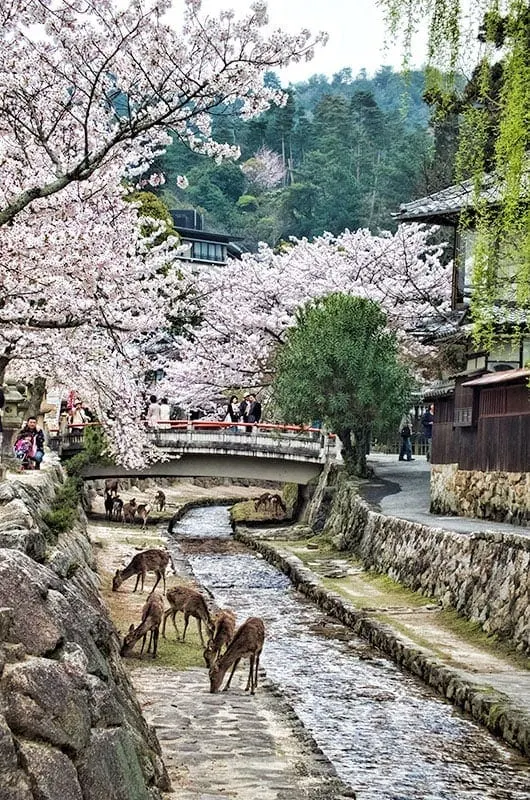
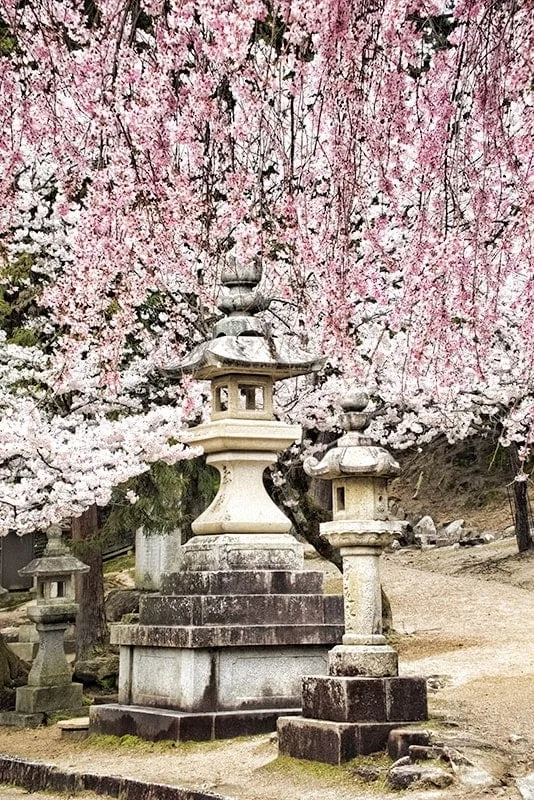
Eat the local specialties
If you’ve been on this site before you know that food is a huge part of our travel experience and we love to try out the local specialties. Miyajima Island might be the perfect place for this as the specialties will appeal to a wide range of tastes. Firstly the area is well known for its oysters, you will probably spot some of the oyster beds in the bay off in the distance from the ferry on the way across. These oysters are served in various forms at many of the restaurants in the shopping street on the island, you can even get some freshly shucked and grilled as a snack as you pass through.
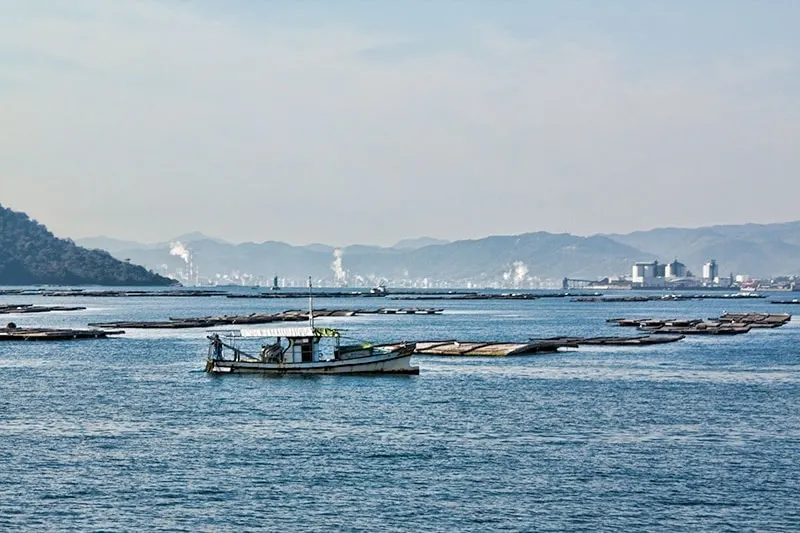
The other specialty is a form of Japanese sweet. It’s called Momiji Manjyu and is a small cake in the shape of the maple leaf (momiji) traditionally filled with sweet red azuki bean paste. While the original form is delicious there are lots of other varieties, the matcha was delicious!
You can buy a few for a snack but these will keep a while and are beautifully presented so they’re a popular souvenir or gift. Giving a gift to colleagues, family and friends when you return from a holiday is a custom called omiyage in Japan and momiji manjyu are a popular choice.
When to Visit Miyajima
Like so many parts of Japan seasons play a big role on Miyajima Island but I would happily visit at any time of year.
Spring
We personally loved seeing the island in full cherry blossom (sakura), this is a very popular time to visit. In addition to the maple trees, the hillsides are equally covered in cherry trees and create a spectacular display. Spring is also also a good temperature for active exploring, although it does tend to be overcast with some showers we’ve not found they have impacted our March / April travel too much.
Summer
Summer can be humid with temperatures 30-35°c. It might be a little warm for hiking but August is fireworks season in Japan and there’s a stunning display over the bay plus there’s the biggest event of the year at Itsukushima Shrine, the Kangan festival.
Autumn or Fall
Miyajima Island is known for its maple trees and their jewel toned display during the fall, this is even more renowned here than the dramatic sakura blossom display. Most of the trees are inside the island a little so allow time to explore beyond the foreshore and Itsukushima shine.
You should also try the regional souvenir, the Momiji Manju, a maple leaf-shaped pastry with a sweet red bean filling although now you can have a variety of different flavours. The weather may be ideal for exploring especially if you want to climb the mountain rather than taking the ropeway.
Winter
Winter can provide some clear days that allow great views from the top of Mt Misen out over the Seto Inland Sea. While you will want a warm jacket or coat with you it’s rarely bitterly cold either. We’ve visited in winter (February) and while the many deciduous trees are bare it’s still very pretty. Winter is also the season of Oysters, you will see the oyster farms from the ferry on the way out, I highly recommend trying them either as a snack or you meal on the island.
Miyajima Accommodation
There is a range of accommodation options on the island, these are on the more pricey end but for the experience of wandering the island at night after everyone has returned home or watching the sun come up in the morning, it could definitely be worth it. If you are wanting to stay on the island just be careful to ensure that is what you are getting when you book, we’ve found a few places called Miyajima but they are on the mainland side.
I have my eye on Jukeiso on Miyajima Island for a night on our next visit. If you are after a ryokan experience this could be for you, it has Japanese style rooms but with private bathrooms, there’s an indoor communal onsen and a private one you can reserve outside with a view of the shrine. They run a shuttle to and from the ferry (just get the info desk in the ferry terminal to call for you when you arrive) and you can book either with breakfast and dinner or just breakfast included.
Staying in Hiroshima City is definitely an option though and it’s what we have done previously. If time is limited it allows you to be more flexible, the variety of accommodation is greater as are restaurants and other activities.
The Hotel Granvia Hiroshima is a chain in Japan that is located adjacent to the train station but don’t let that put you off, we’ve never experienced any noise disruption and they are an excellent quality hotel with great facilities and all the conveniences you need like a good variety of restaurants and tram stops nearby. We often take day trips from a central base so being conveniently located to the transport works well for us and it’s not difficult to walk or take the tram into the city and attractions.
Alternatively, the Crown Plaza ANA Hiroshima is another we have used that is close to the Peace Park and the city centre, it’s well-appointed, a good location and we’ve found good deals here too. You can get a tram from the train station to a stop right outside or we got a taxi with our luggage which is quite reasonably priced for this short distance.
Miyajima Island Visitor Information
Getting there
Miyajima Island is a 30 minute (Y410) train trip on the Sanyo line from Hiroshima station. Get off the train at Miyajimaguchi and cross the road to the ferry stop. The JR ferry takes 10 minutes to make the crossing and costs Y180. If you are using the JR pass both the train and ferry are included in that.
If you are coming from further afield Hiroshima is about 2 hours from Kyoto or 1 hour 40 minutes from Osaka using bullet trains under the JR Pass, slightly faster if using Nozomi options.
Fees and Charges
There are no fees to access the island but some shrine and temple buildings have a small entry fee/donation.
Facilities
There are public toilets on the island and spaces to enjoy a picnic. There is also a range of restaurants and places to buy snacks and drinks mostly located in the Omotesando shopping street.
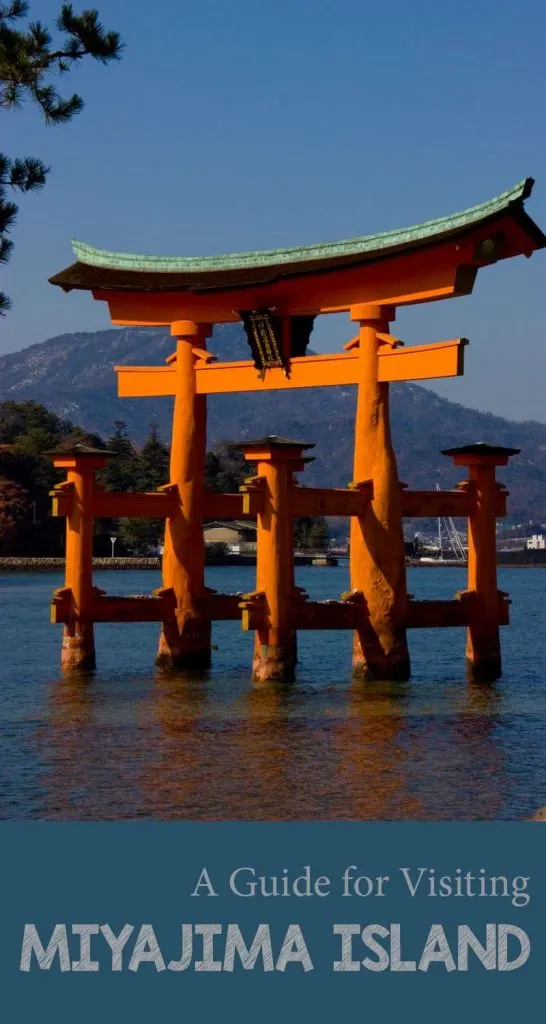
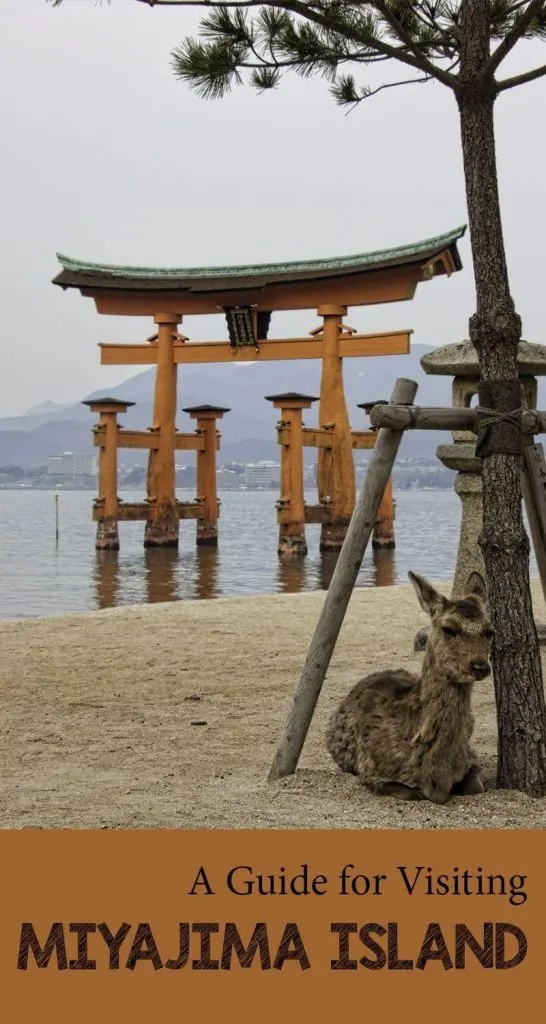
If you’ve been to Miyajima Island what was your favourite part, if you’re planning on visiting what are you most interested in seeing?
Lloyd
Saturday 22nd of July 2023
What a fantastic description regarding things to do
Evelyn Finch
Saturday 9th of March 2019
I am so looking forward to this adventure this summer.
Paul
Saturday 26th of January 2019
Thanks again for another great article that helped us get the most out of our day trip to Miyajima Island. Managed to time high tide perfectly on a clear crisp winters day. Keep up the good work. Paul.
Toni Broome
Saturday 26th of January 2019
Thanks Paul. It's good to hear the information has been useful and that got such an ideal day for your trip out to Miyajima Island, it's such a special place.
Debbie Stein
Friday 17th of August 2018
I spent a day on Miyajima Island in July with my husband and 2 teenage daughters. The night before I checked the tides: high tide was at 5.10am that day and low was around midday. We decided to arrive mid to late morning, and I must say it is equally lovely at low tide. You can stand under it and there are coins everywhere, on and around the structure. It was a humid and hot day, so a nice way to spend some time in air conditioning, was to visit the aquarium (which I recommend), then we had lunch. Storm clouds were building in the distance but we decided to risk it and find the ropeway, and head on up to Mt Misen for the walk to the top. By this stage there was thankfully some cloud cover, however a rain storm never eventuated, which enabled us to enjoy the walk, visit the temples and pass by the rock formations, to the beautiful view to the top. As we had spent the whole afternoon on the island, we got to see the tori gate at high tide as well, when we were leaving around 6pm. It is such an awesome place, and it would be lovely to see it in a different season as well. Yes the summer time was hot and humid, but bearable. We made sure we had plenty of water, so make sure you do the same if you visit in summer.
Toni Broome
Friday 17th of August 2018
Thanks for sharing your experience of Miyajima Island Debbie, pleased to hear you enjoyed your day over there.
Moira
Thursday 6th of October 2016
Thank you for your fabulous blog and photos! I will be staying here with my husband and two adult children over Christmas for 3 nights so it is great to see where we will be! It will be interesting to experience a more tranquil side of Japanese life.It will be certainly different from a New Zealand Christmas, that's for sure!
2 Aussie Travellers
Friday 7th of October 2016
That will be amazing way to spend the holidays Moira! We both lived a large part of our lives in New Zealand too and you are right, it is going to be a very different and fun experience. Have fun!